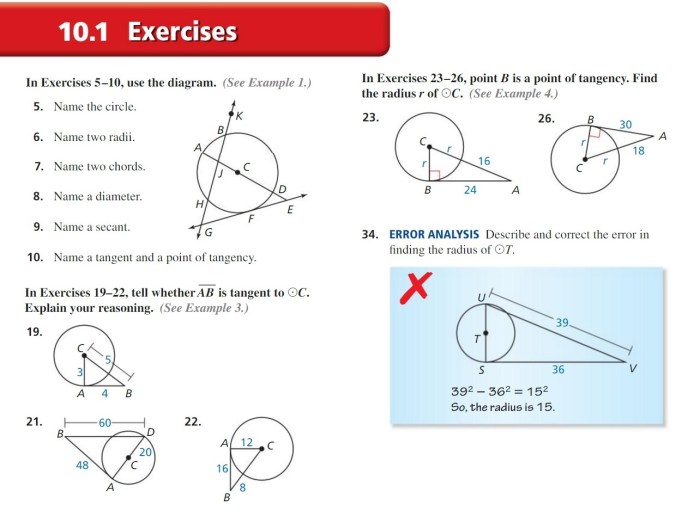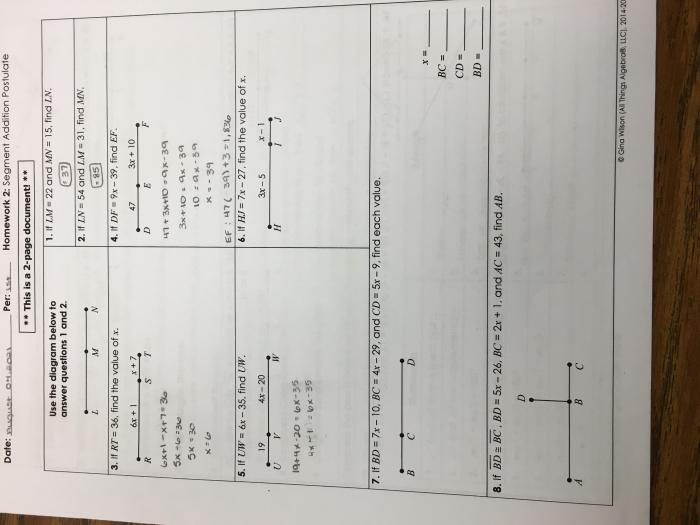Prepare to embark on a captivating journey with Unit 10 Circles Homework 2. This exploration will illuminate the intriguing world of circular geometry, revealing its fascinating properties, practical applications, and the captivating relationships it forms with other geometric shapes.
From the familiar circles we encounter in everyday life to the intricate mathematical principles that govern their behavior, this assignment delves into the heart of circular knowledge. Get ready to unravel the secrets of circles and discover their profound impact on our world.
Circle Definitions

A circle is a closed, two-dimensional shape defined by a fixed point (the center) and a constant distance (the radius) from that point to any point on the circle. In other words, it’s the set of all points in a plane that are equidistant from a given point.
Alright, time to wrap up Unit 10 Circles Homework 2. If you’re looking for a deeper dive into the themes of star-crossed lovers, check out this thesis on Romeo and Juliet . It might give you some fresh insights for your own essay.
But don’t forget to come back and finish that homework!
Circles are common in everyday life. Examples include the wheels of a car, the face of a clock, and the iris of an eye.
Calculating Circumference
The circumference of a circle is the distance around the circle. It can be calculated using the formula:
C = 2πr
where:
- C is the circumference
- π (pi) is a mathematical constant approximately equal to 3.14
- r is the radius of the circle
Circle Properties: Unit 10 Circles Homework 2

Circles are defined by their unique properties, which include symmetry and central points. They exhibit a perfect balance and harmony in their form, making them a fascinating subject of study.
One of the key properties of a circle is its symmetry. Circles are symmetrical about their center point, meaning that any line drawn through the center divides the circle into two congruent halves. This symmetry is evident in various real-world applications, such as the design of wheels, gears, and architectural structures.
Relationship between Radius and Diameter
Another important property of circles is the relationship between their radius and diameter. The radius of a circle is the distance from the center to any point on the circle, while the diameter is the distance across the circle passing through the center.
The diameter of a circle is always twice its radius, and this relationship is expressed mathematically as:
Diameter = 2 × Radius
Understanding this relationship is crucial for various applications, such as calculating the circumference and area of circles, which are discussed in subsequent sections.
Real-World Applications
The properties of circles find widespread applications in various fields, including engineering, architecture, and design. The symmetry of circles makes them ideal for creating balanced and aesthetically pleasing structures, such as domes, arches, and bridges. The relationship between radius and diameter is essential in designing gears and pulleys, where precise measurements are critical for smooth operation.
Circle Measurement

Measuring a circle involves determining its radius, diameter, and circumference. These measurements are crucial for understanding the size and shape of a circle.
Radius and Diameter
The radius of a circle is the distance from its center to any point on its circumference. The diameter is twice the radius and represents the length of a straight line passing through the center and connecting two points on the circumference.
- Radius (r): The distance from the center to any point on the circumference.
- Diameter (d): Twice the radius, connecting two points on the circumference through the center.
Circumference
The circumference of a circle is the distance around its perimeter. It is calculated using the formula 2πr, where π (pi) is a mathematical constant approximately equal to 3.14159.
Circumference = 2πr
Table of Circle Measurement Formulas
The following table summarizes the formulas for circle measurements:
| Measurement | Formula |
|---|---|
| Radius | r |
| Diameter | d = 2r |
| Circumference | C = 2πr |
Circle Relationships
Circles interact with other geometric shapes in various ways, forming relationships that influence design and architecture.
Inscribed and Circumscribed Circles
An inscribed circle lies within a polygon, touching each side. Conversely, a circumscribed circle encloses a polygon, passing through all its vertices.
- Inscribed Circle:Maximizes the area within the polygon.
- Circumscribed Circle:Minimizes the perimeter of the polygon.
These relationships are used in design to create harmonious shapes and optimize space utilization.
Circles and Squares, Unit 10 circles homework 2
A square can be inscribed in a circle, with its vertices touching the circle’s circumference. Conversely, a circle can be circumscribed around a square, passing through its corners.
This relationship is often used in architecture to create balanced and symmetrical designs, such as in domes and arches.
Circles and Triangles
Circles can also be inscribed in and circumscribed around triangles.
- Inscribed Circle:Touches the midpoints of the triangle’s sides.
- Circumscribed Circle:Passes through the vertices of the triangle.
These relationships are used in geometry to solve problems and prove theorems.
Circle Applications

Circles find widespread applications in various fields due to their unique geometric properties. They are commonly used in engineering, physics, art, and even everyday objects.
In engineering, circles are used in the design of gears, bearings, and other mechanical components. They are also used in the construction of bridges, tunnels, and other structures. In physics, circles are used to describe the motion of planets, the behavior of waves, and the properties of light.
Art and Design
In art and design, circles are used to create a sense of balance and harmony. They are often used in logos, symbols, and other visual elements. Circles can also be used to create a sense of movement or depth.
Everyday Objects
Circles are also used in a variety of everyday objects, such as wheels, clocks, and coins. They are also used in the design of furniture, appliances, and other household items.
Innovative Uses
In modern society, circles are being used in innovative ways. For example, they are being used to develop new medical technologies, such as artificial joints and implantable devices. Circles are also being used in the design of new energy-efficient buildings and transportation systems.
Essential Questionnaire
What is the formula for calculating the circumference of a circle?
C = 2πr
What is the relationship between the radius and diameter of a circle?
The diameter is twice the length of the radius: d = 2r
What is the concept of pi (π) and its role in circle measurements?
Pi (π) is a mathematical constant approximately equal to 3.14. It represents the ratio of a circle’s circumference to its diameter and is essential for calculating circle measurements.